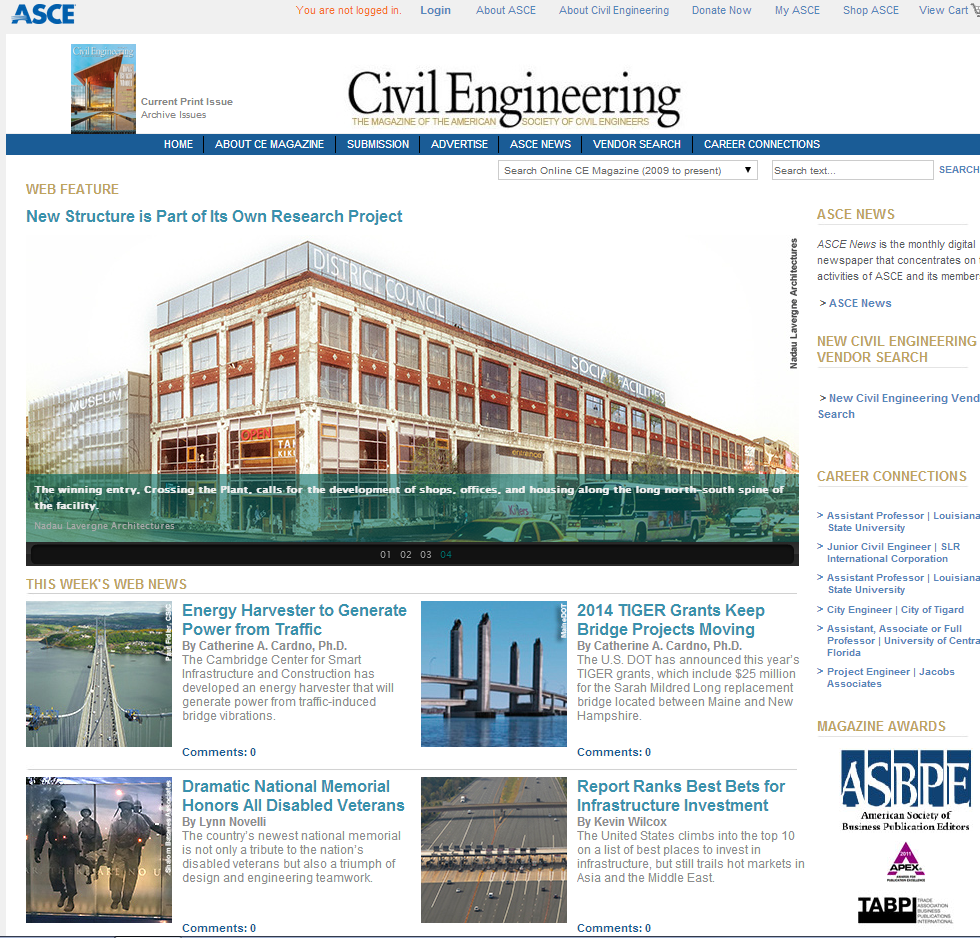
Submitted by Administrator on Mon, 27/10/2014 - 11:22
The CSIC website story about the proposed testing of vibration energy harvesting on the Forth Road Bridge has made front page news on the award-winning, monthly flagship magazine of the American Society of Civil Engineers, Civil Engineering. Reaching an audience of 140,000 civil engineers worldwide, this magazine has the largest circulation in the engineering market.
Here’s the story as it appeared in the title:
Energy Harvester to Generate Power from Traffic
By Catherine A. Cardno, Ph.D.
The Cambridge Center for Smart Infrastructure and Construction has developed an energy harvester that will generate power from traffic-induced bridge vibrations.
October 14, 2014—Knowledge is power. This is certainly true for the continued safe operation of aging bridges for which monitoring by wireless sensors can provide a steady stream of information about such ambient characteristics as air temperature and humidity and such physical parameters as displacement, strain, inclination, or vibration. But wireless sensors, although cable-free, are still powered by battery packs that must be regularly charged or replaced. This requires that the sensors be located in physically accessible spaces, despite their wireless capabilities.
The Cambridge Center for Smart Infrastructure and Construction, or CSIC, located at the University of Cambridge in the United Kingdom, is developing a next-generation power pack for use by wireless sensors that will obviate the need for people to physically check them. The technology—which currently exists as a prototype—is a vibration energy harvester that uses the traffic-induced vibrations of a bridge to generate electricity so that wireless sensors can remain in place longer without the need to be physically accessed.
The technology will be tested on the Forth Road Bridge, a 2.5 km long-span suspension bridge that opened 50 years ago near Edinburgh, Scotland. While the bridge currently experiences approximately 25 million vehicle crossings annually, that number will drop significantly in 2016 once a new bridge—the Queensferry Crossing—opens and the Forth Road Bridge is restricted to cyclists, taxis, and mass-transit vehicles.
The CSIC partnered with Transport Scotland to use the bridge as a field-test site for the vibration energy harvester. “This opportunity to test in real-world conditions ensures that the technologies we develop are robust and can then be developed to be taken up by industry relatively quickly,” said Jennifer Schooling, Ph.D., the director of the CSIC, in a written response to questions posed by Civil Engineering online.
The Forth Road Bridge is a good candidate for field-testing of the next-generation energy harvester “due to the characteristics of the ambient vibration,” said Campbell Middleton, Ph.D., CEng, CPEng, a professor of construction engineering at the University of Cambridge and one of the researchers at the CSIC. Middleton also wrote in response to questions posed by Civil Engineering online.
“The deck of the Forth Road Bridge is made up of a number of separate steel plates and produces a characteristic double ‘thump’ as cars drive across,” Middleton explained. “The combined effect of these thumps leads to a lot of vibration, but not necessarily the constant, predictable vibration needed by some energy-harvester designs.”
Parametric resonance, which amplifies vibrations, is the key to the new technology’s ability to collect energy despite the unpredictable and inconsistent vibrations experienced by the bridge, according to Yu Jia, Ph.D., a research associate at the CSIC’s Nanoscience Center at Cambridge University, who wrote in response to questions posed by Civil Engineering online
“We have been developing a unique vibration energy-harvesting technology by employing parametric resonance to drastically improve the amount of captured vibration energy compared to the conventional vibration energy-harvesting solutions,” Jia said. “Such harvesters are helpful to generate decentralized energy for low-power systems such as wireless sensor motes.”
Harvesting energy from traffic-induced vibrations is complicated, according to Jia, because of “the scarcity of large vibrational energy and the random, broadband nature of real vibration.” By designing the new harvester prototypes specifically for the vibration profiles experienced on the Forth Road Bridge and boosting those vibrations with parametric resonance, the team was able to create a system that can harvest “a significantly larger vibration spectrum than the conventional resonant harvesters,” Jia said.
A range of macroscale prototypes of the harvester have been built, comparable in dimensions to two 4.5 volt batteries to a single 9-volt battery, according to Jia.
Future research by CSIC will follow two parallel tracks. The team will work to further optimize and improve the robustness of the macroscale harvesters while conducting the Forth Road Bridge field tests. At the same time, the team will be developing microelectromechanical energy harvesters that are the size of a dollar coin, or smaller, according to Jia.
Field testing of the vibration-harvesting system on the Forth Road Bridge is planned for spring 2016.
The CSIC is cofunded by the Engineering and Physical Sciences Research Council, the United Kingdom’s main agency for funding research in engineering and the physical sciences, and Innovate U.K., the government body promoting innovation and technology development in the United Kingdom.
To see the article as it appeared in ASCE click here
For more information see www.asce.org/cemagazine
